Analysis of the Magnetohydrodynamic Behavior of the Fully Developed Flow of Conducting Fluid
Abstract
1. Introduction
2. Multiphysics Magnetohydrodynamic Equations
2.1. Maxwell’s Equations
2.2. Magnetohydrodynamics Equations
2.3. Analytical Equations for Fully Developed MHD Flow in Circular Pipes
3. Finite Volume Method for Magnetohydrodynamic Problems
4. Magnetohydrodynamic Model in a Duct
4.1. OpenFOAM Numerical Software for Solving MHD Problems
4.2. Geometry Model
4.3. Parameters of MHD Simulations
4.4. Verification of Results
4.5. Analysis of Fluid Behavior in the Repulsive Configuration
4.6. Analysis of Fluid Behavior in the Attractive Configuration
4.7. Comparative Analysis of Electromagnetic Behavior
5. Final Remarks
Author Contributions
Funding
Institutional Review Board Statement
Informed Consent Statement
Data Availability Statement
Acknowledgments
Conflicts of Interest
Abbreviations
| CFD | Computational Fluid Dynamics |
| FEM | Finite Element Method |
| FVM | Finite Volume Method |
| MHD | Magnetohydrodynamics |
| Variables | |
| Ha | Hartmann number |
| Re | Reynolds number |
| N | Stuart number |
| Rem | Magnetic Reynolds number |
| Al | Alfvén number |
| Magnetic flux density or magnetic induction | |
| Axial component of magnetic induction | |
| Radial component of magnetic induction | |
| Current density | |
| Flow velocity | |
| U | Average flow velocity over the cross-section |
| L | Characteristic length |
| Electric charge density | |
| Magnetic permeability | |
| Magnetic permeability of free space | |
| Electric conductivity | |
| p | Pressure |
| Density of fluid | |
| Dynamic viscosity of fluid | |
| Kinematic viscosity of fluid | |
| Magnetic damping time | |
| Time step of numerical simulation | |
| Courant-Friedrichs-Lewy condition | |
| Von Neumann stability analysis |
References
- Davidson, P. An Introduction to Magnetohydrodynamics, 2nd ed.; Cambridge University Press: Cambridge, UK, 2017. [Google Scholar]
- Hartmann, J. Theory of the laminar flow of an electrically conductive liquid in a homogeneous magnetic field. Math.-Fys. Meddelelser 1937, 15, 3–28. [Google Scholar]
- Alfvén, H. Existence of Electromagnetic-Hydrodynamic Waves. Nature 1942, 150, 405–406. [Google Scholar] [CrossRef]
- Shercliff, J.A. A Textbook of Magnetohydrodynamics; Pergamon Press: Oxford, UK, 1965. [Google Scholar]
- Sutton, G.; Sherman, A. Engineering Magnetohydrodynamics; Dover Publications: Mineola, NY, USA, 2006. [Google Scholar]
- Shahri, M.F.; Nezhad, A.H. Quasi-two-dimensional case studies of MHD flow and heat transfer behind a square cylinder in a duct. Int. J. Appl. Electromagn. Mech. 2015, 49, 123–132. [Google Scholar] [CrossRef]
- Li, D. Numerical Solution of the Time-harmonic Maxwell Equations and Incompressible Magnetohydrodynamics Problems. Ph.D. Thesis, The University of British Columbia, Vancouver, BC, Canada, 2010. [Google Scholar]
- Davidson, P.A. Magnetohydrodynamics in materials processing. Annu. Rev. Fluid Mech. 1999, 31, 273–300. [Google Scholar] [CrossRef]
- Segatz, M.; Droste, C. Analysis of Magnetohydrodynamic Instabilities in Aluminum Reduction Cells. In Essential Readings in Light Metals; Springer: Berlin/Heidelberg, Germany, 2016; pp. 342–351. [Google Scholar]
- Liu, Z.; Vakhrushev, A.; Wu, M.; Karimi-Sibaki, E.; Kharicha, A.; Ludwig, A.; Li, B. Effect of an Electrically-Conducting Wall on Transient Magnetohydrodynamic Flow in a Continuous-Casting Mold with an Electromagnetic Brake. Metals 2018, 8, 609. [Google Scholar] [CrossRef]
- Veranda, M.; Bonfiglio, D.; Cappello, S.; Escande, D.F.; Auriemma, F.; Borgogno, D.; Chacón, L.; Fassina, A.; Franz, P.; Gobbin, M. Magnetohydrodynamics modelling successfully predicts new helical states in reversed-field pinch fusion plasmas. Nucl. Fusion 2017, 57, 116029. [Google Scholar] [CrossRef]
- Zhang, S.; Chen, L.; Meng, Z.; Guangyu, Z. Numerical research of magnetohydrodynamics buoyant flow in dual functional lead lithium fusion blanket. Fusion Eng. Des. 2019, 149, 111331. [Google Scholar] [CrossRef]
- Lu, P.; Zheng, X.; Fang, L.; Huang, H.; Xu, S.; Yu, Y. Numerical Study of the Gas-Liquid Two-Phase Flow in a Self-Designed Mixer for a Ga-R113 MHD System. Energies 2017, 10, 1629. [Google Scholar] [CrossRef]
- Dibazar, S.Y.; Salehi, G.; Davarpanah, A. Comparison of Exergy and Advanced Exergy Analysis in Three Different Organic Rankine Cycles. Processes 2020, 8, 586. [Google Scholar] [CrossRef]
- Ehyaei, M.A.; Ahmadi, A.; Rosen, M.A.; Davarpanah, A. Thermodynamic Optimization of a Geothermal Power Plant with a Genetic Algorithm in Two Stages. Processes 2020, 8, 1277. [Google Scholar] [CrossRef]
- Li, L.; Huang, H.L.; Zhu, G.P. Numerical Simulations for a Partial Disk MHD Generator Performance. Energies 2018, 11, 127. [Google Scholar] [CrossRef]
- Alabi, A.; Chiesa, M.; Garlisi, C.; Palmisano, G. Advances in anti-scale magnetic water treatment. Environ. Sci. Water Res. Technol. 2015, 1, 408–425. [Google Scholar] [CrossRef]
- Martins, A.; Ferreira, M.; Neto, J.; Vianna, A.; Ressel, F.; Santos, R.; Rosa, K. Aplicação de Dispositivos Magnéticos no Combate à Incrustações Inorgânicas (in Portuguese). In Proceedings of the VII Congresso Nacional de Engenharia Mecânica (CONEM 2012), São Luís, Brazil, 31 July–3 August 2012. [Google Scholar]
- Shang, J. Computational Electromagnetic-Aerodynamics; John Wiley & Sons: Hoboken, NJ, USA, 2016. [Google Scholar]
- Fonseca, W.S.; Lima, D.S.; Lima, A.; Nunes, M.V.A.; Bezerra, U.H.; Soeiro, N.S. Analysis of Structural Behavior of Transformer’s Winding Under Inrush Current Conditions. IEEE Trans. Ind. Appl. 2018, 54, 2285–2294. [Google Scholar] [CrossRef]
- Lima, D.S.; Mahmud, L.S.; Sousa, A.R.M.d.; Fonseca, W.S.; Bezerra, U.H.; Bezerra, F.V.V. Electromagnetic analysis of single-phase transformer banks under sympathetic inrush phenomenon. Int. J. Appl. Electromagn. Mech. 2020, 62, 541–556. [Google Scholar] [CrossRef]
- Schellekens, H.; Wu, Y.; Wang, L.; Qian, Z.; Godechot, X. 3D MHD vacuum arc model in VI design. Int. J. Appl. Electromagn. Mech. 2019, 59, 417–425. [Google Scholar] [CrossRef]
- Beckstein, P.; Galindo, V.; Gerbeth, G. Free-surface dynamics in the Ribbon Growth on Substrate (RGS) process. Int. J. Appl. Electromagn. Mech. 2017, 53, S43–S51. [Google Scholar] [CrossRef]
- Menana, H.; Charpentier, J.F.; Gabillet, C. Contribution to the MHD Modeling in Low Speed Radial Flux AC Machines with Air-Gaps Filled with Conductive Fluids. IEEE Trans. Magn. 2014, 50, 1–4. [Google Scholar] [CrossRef]
- Ferziger, J.; Perić, M.; Street, R. Computational Methods for Fluid Dynamics, 4th ed.; Springer Nature: Basel, Switzerland, 2019. [Google Scholar]
- Lim, J.; Choi, H.; Kim, J. Control of streamwise vortices with uniform magnetic fluxes. Phys. Fluids 1998, 10, 1997–2005. [Google Scholar] [CrossRef]
- Homaee, O.; Gholami, A. Prestrike modeling in SF6 circuit breakers. Int. J. Electr. Power Energy Syst. 2020, 114. [Google Scholar] [CrossRef]
- Tassone, A.; Magnetic Induction and Electric Potential Solvers for Incompressible MHD Flows. CFD with OpenSource Software. 2016. Available online: https://dokumen.tips/documents/magnetic-induction-and-electric-potential-solvers-for-hanikurseroscfd2016alessandrotassone.html (accessed on 19 March 2021).
- Shercliff, J.A. Steady motion of conducting fluids in pipes under transverse magnetic fields. Math. Proc. Camb. Philos. Soc. 1953, 49, 136–144. [Google Scholar] [CrossRef]
- Hunt, J. Magnetohydrodynamic flow in rectangular ducts. J. Fluid Mech. 1965, 21, 577–590. [Google Scholar] [CrossRef]
- Uhlenbusch, J.; Fischer, E. Hydromagnetische Strömung im kreiszylindrischen Rohr (in German). Z. Phys. 1961, 164, 190–198. [Google Scholar] [CrossRef]
- Gold, R. Magnetohydrodynamic pipe flow. Part 1. J. Fluid Mech. 1962, 13, 505–512. [Google Scholar] [CrossRef]
- Moukalled, F.; Mangani, L.; Darwish, M. The Finite Volume Method in Computational Fluid Dynamics; Springer International Publishing: Basel, Switzerland, 2016. [Google Scholar]
- Valls, E.M. Development of a Simulation Tool for MHD Flows under Nuclear Fusion Conditions. Ph.D. Thesis, Department of Physics and Nuclear Engineering, Universitat Politécnica de Catalunya, Barcelona, Spain, 2011. [Google Scholar]
- The OpenFOAM Foundation. OpenFOAM Version 6. 2018. Available online: https://openfoam.org/version/6 (accessed on 19 March 2021).
- Weller, H.G.; Tabor, G.; Jasak, H.; Fureby, C. A tensorial approach to computational continuum mechanics using object-oriented techniques. Comput. Phys. 1998, 12, 620–631. [Google Scholar] [CrossRef]
- Müller, U.; Bühler, L. Magnetofluiddynamics in Channels and Containers; Springer: Berlin/Heidelberg, Germany, 2001. [Google Scholar]
- Çengel, Y.A.; Cimbala, J.M. Fluid Mechanics—Fundamentals and Applications, 4th ed.; McGraw-Hill Education: New York, NY, USA, 2017. [Google Scholar]

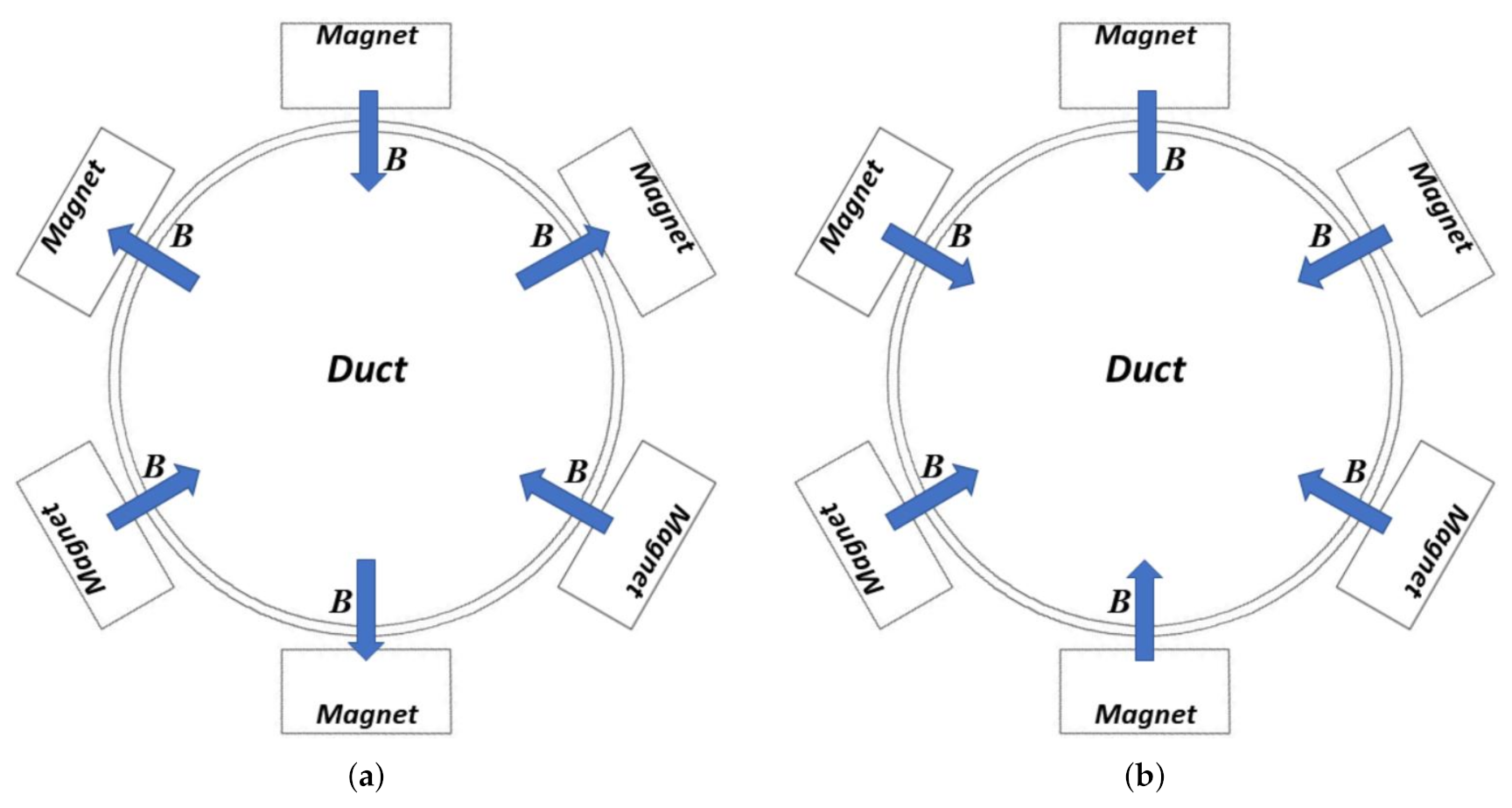

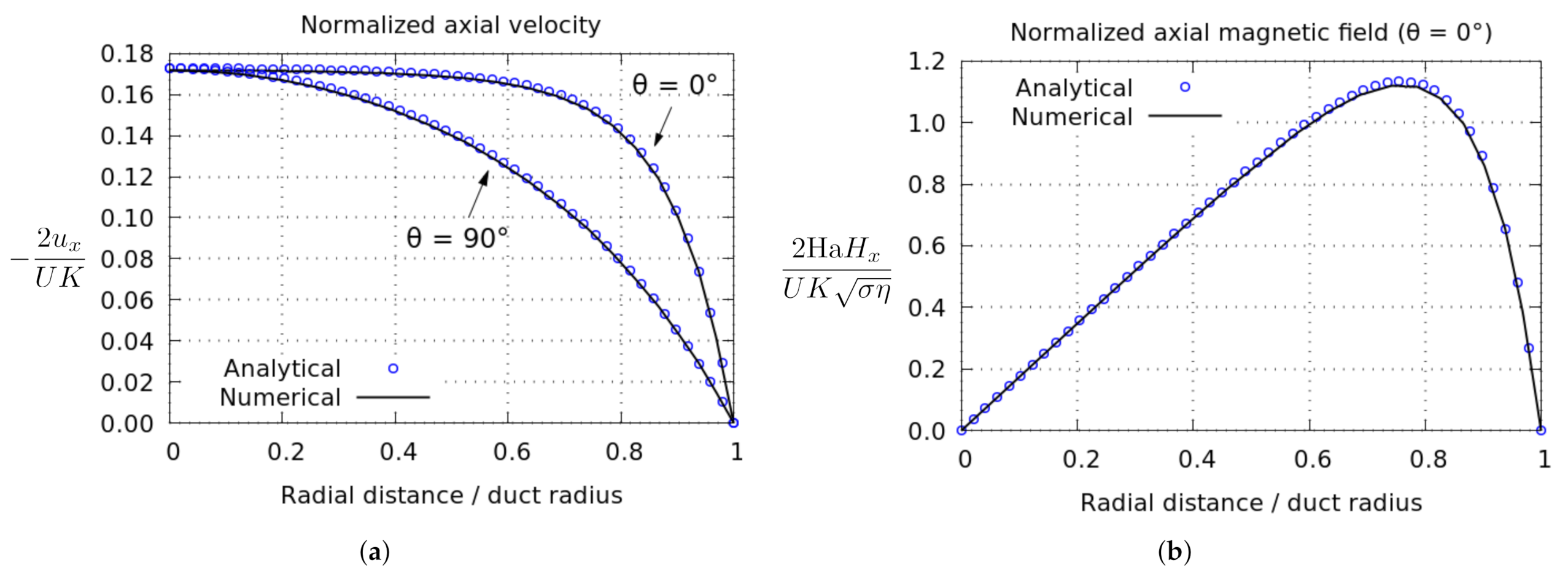
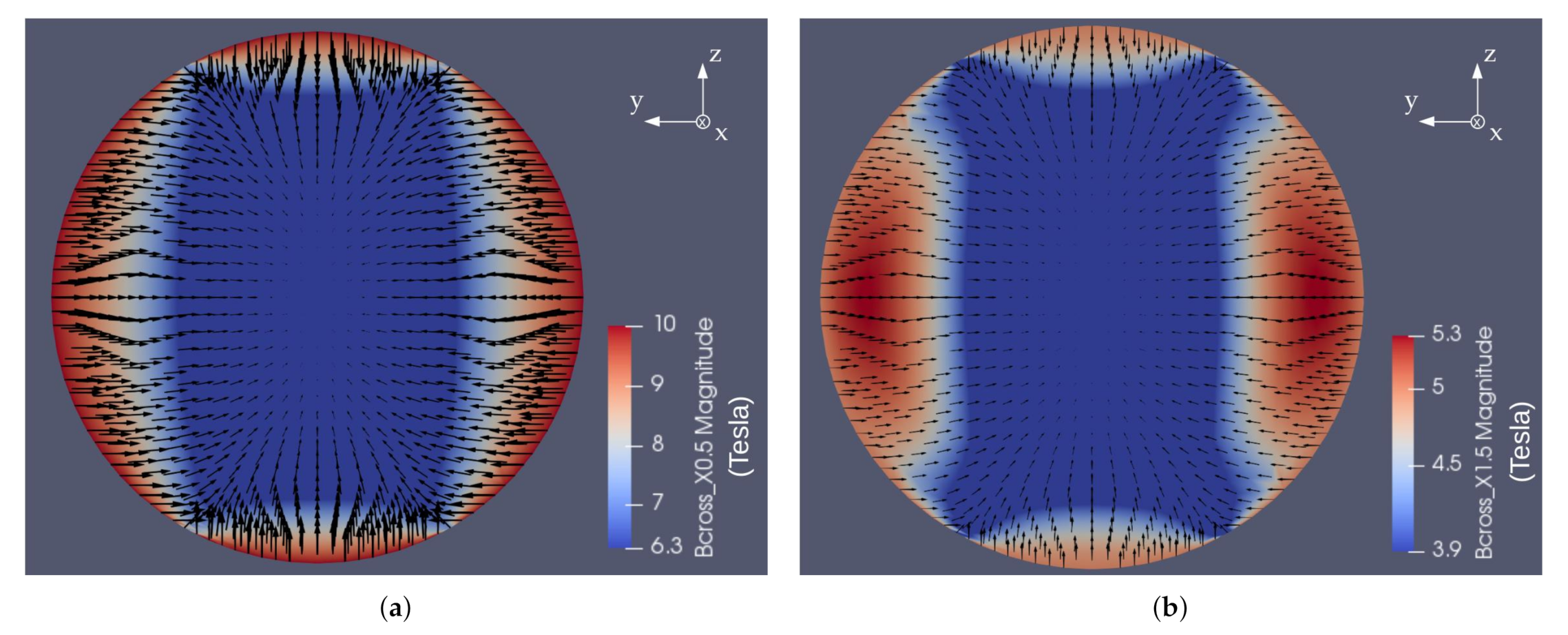

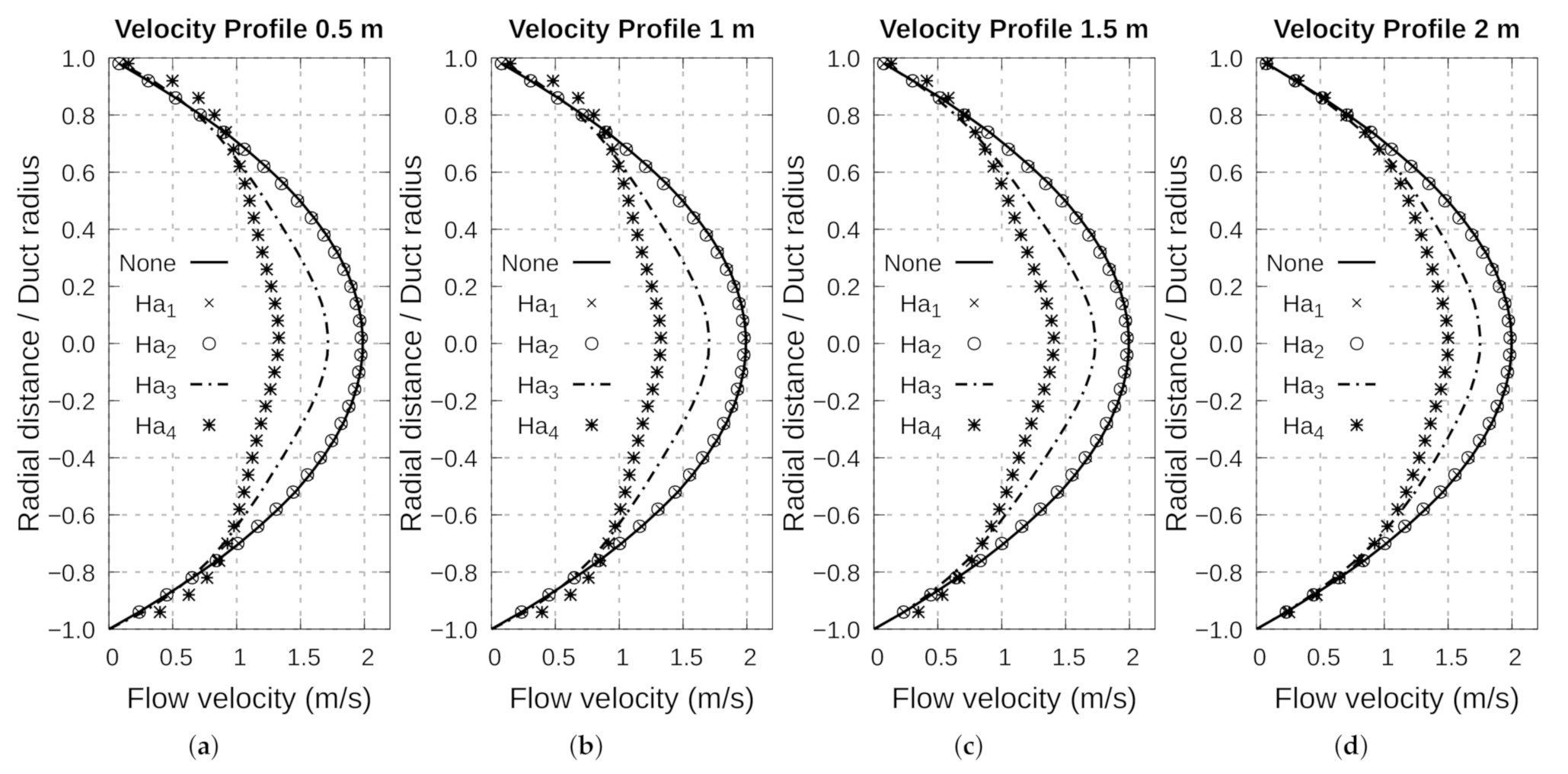


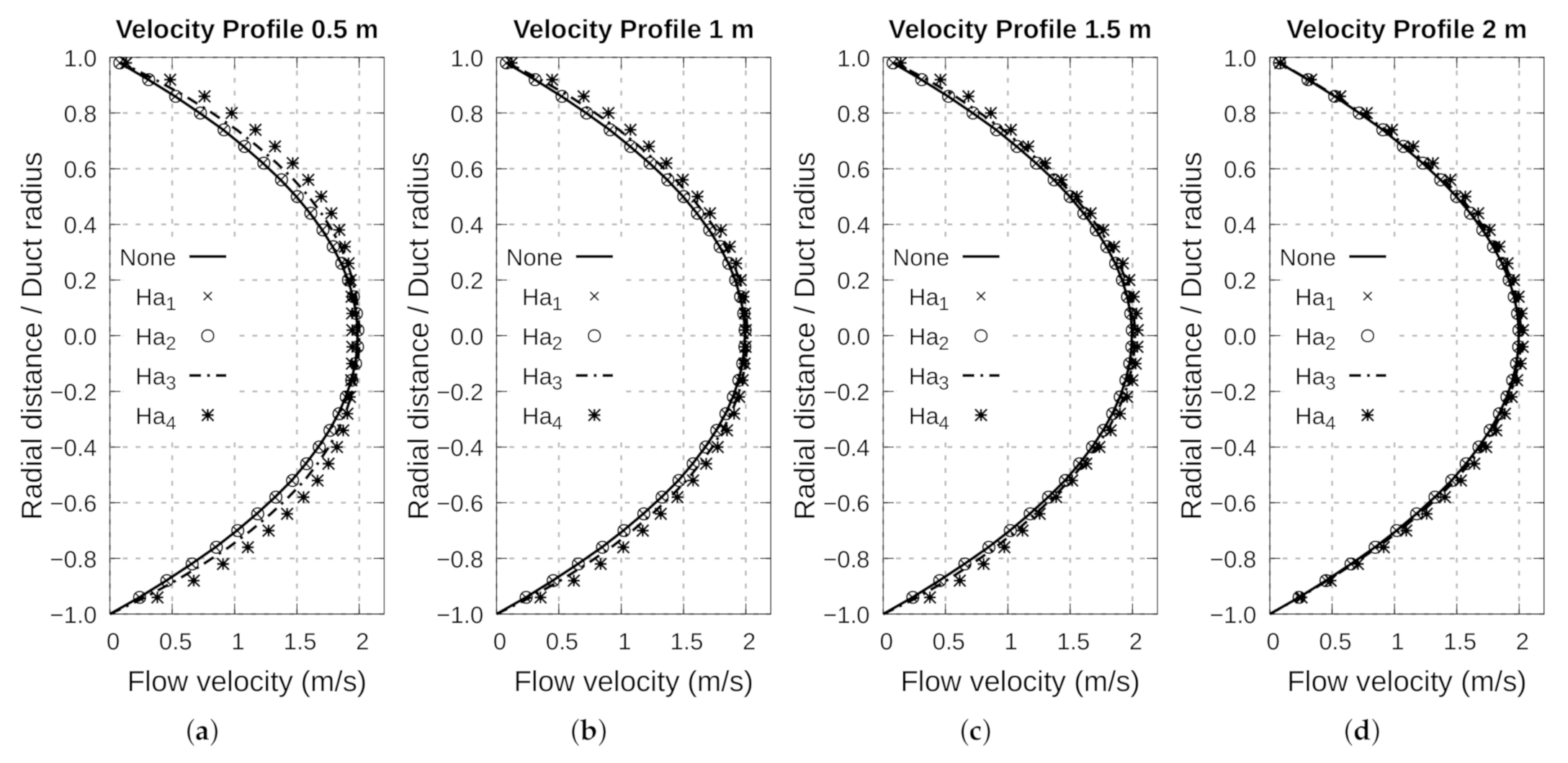
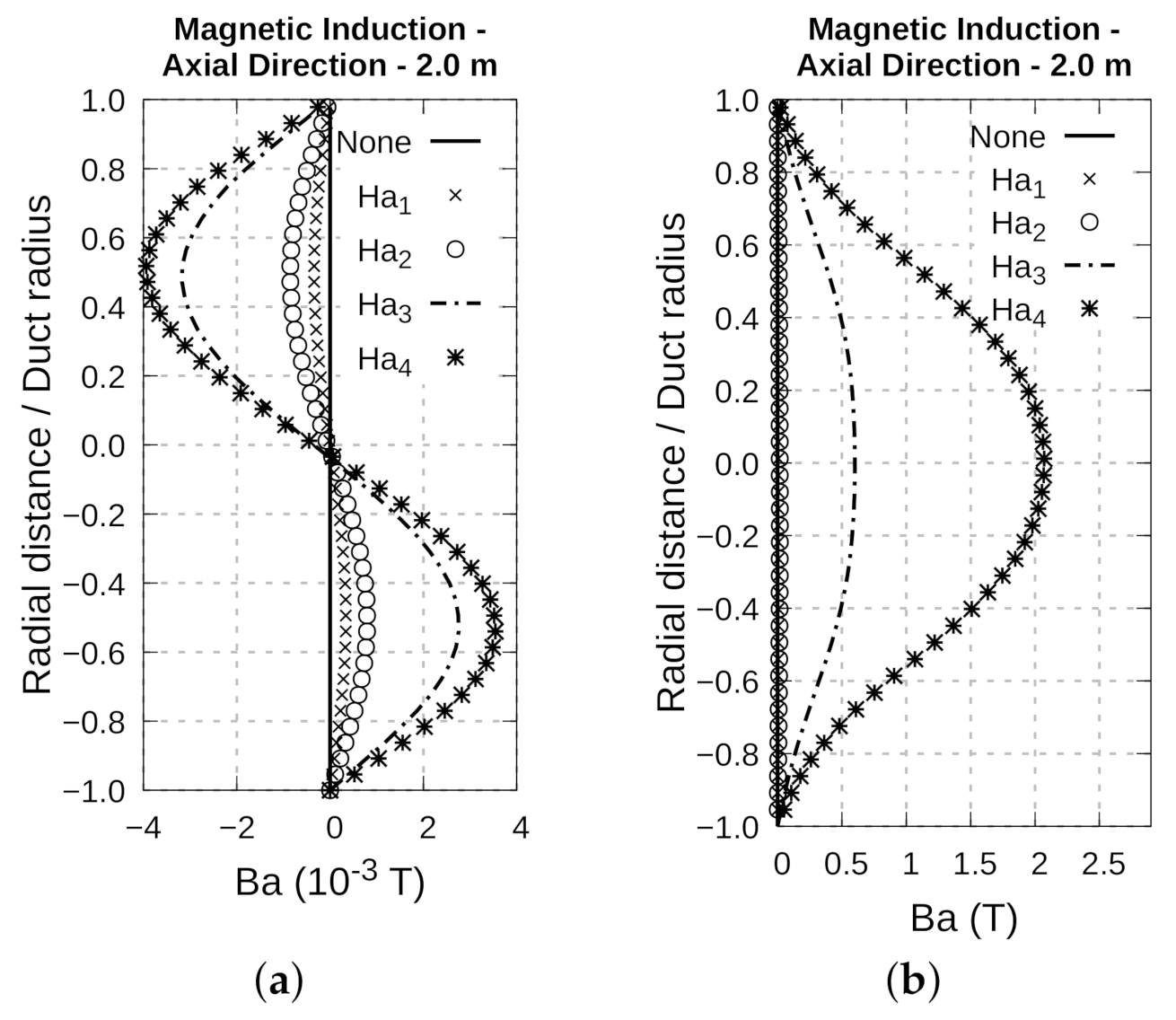

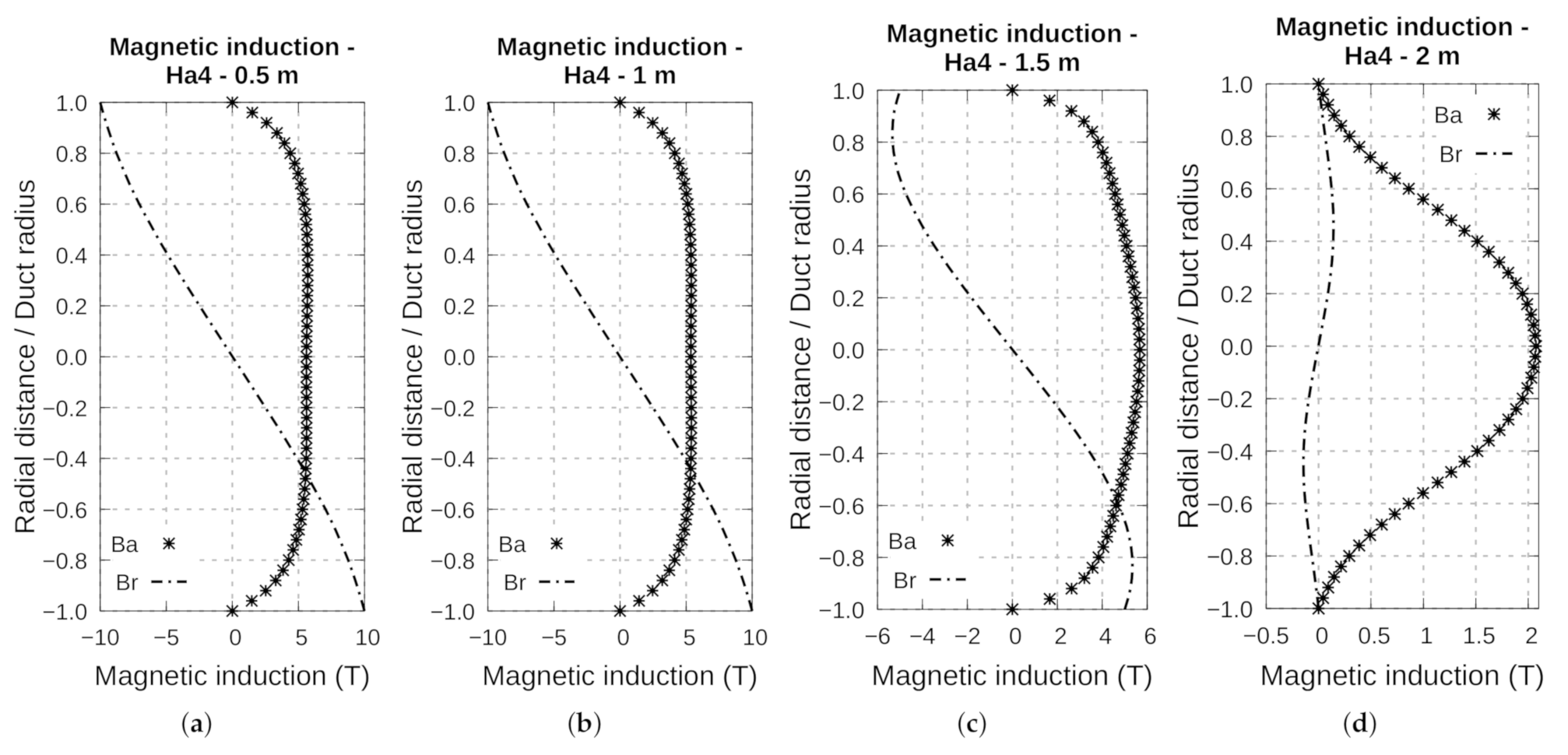
Publisher’s Note: MDPI stays neutral with regard to jurisdictional claims in published maps and institutional affiliations. |
© 2021 by the authors. Licensee MDPI, Basel, Switzerland. This article is an open access article distributed under the terms and conditions of the Creative Commons Attribution (CC BY) license (https://creativecommons.org/licenses/by/4.0/).
Share and Cite
Fonseca, W.d.S.; Araújo, R.C.F.; Silva, M.d.O.e.; Cruz, D.O.d.A. Analysis of the Magnetohydrodynamic Behavior of the Fully Developed Flow of Conducting Fluid. Energies 2021, 14, 2463. https://doi.org/10.3390/en14092463
Fonseca WdS, Araújo RCF, Silva MdOe, Cruz DOdA. Analysis of the Magnetohydrodynamic Behavior of the Fully Developed Flow of Conducting Fluid. Energies. 2021; 14(9):2463. https://doi.org/10.3390/en14092463
Chicago/Turabian StyleFonseca, Wellington da Silva, Ramon C. F. Araújo, Marcelo de Oliveira e Silva, and Daniel Onofre de A. Cruz. 2021. "Analysis of the Magnetohydrodynamic Behavior of the Fully Developed Flow of Conducting Fluid" Energies 14, no. 9: 2463. https://doi.org/10.3390/en14092463
APA StyleFonseca, W. d. S., Araújo, R. C. F., Silva, M. d. O. e., & Cruz, D. O. d. A. (2021). Analysis of the Magnetohydrodynamic Behavior of the Fully Developed Flow of Conducting Fluid. Energies, 14(9), 2463. https://doi.org/10.3390/en14092463





